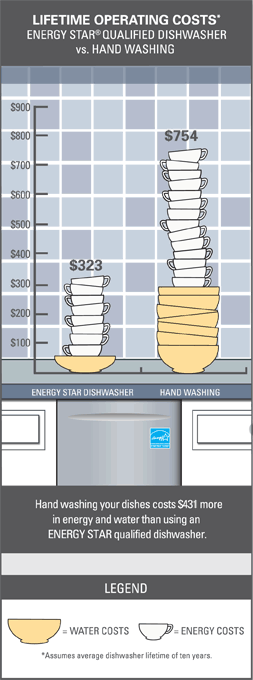
Cleaner dishes the lazy way — and more water-saving tips
A waterless toilet? A dry shower? If these emerging extreme water-saving technologies make you say, “no thank you!” we’ve found some more mainstream options to help you save water and money.
Laziness for the win
When it comes to dirty dishes, taking the easy way out finally pays off.
Hand-washing dishes actually uses more water than running those same dishes through a newer Energy Star dishwasher. Dishwashers made after 2013 are required to use 5 gallons or less per load, and installing a new one can save you almost 5,000 gallons of water per year.
A new dishwasher is not only more efficient, it's also better at getting dishes clean. So don’t spend time rinsing your dishes (although letting Fido lick them clean is still a water-saving option). Simply scrape off your plates and load them. You’ll save time, water and money.
Don’t believe me? Check out this Consumer Report's guide that put dishwashers to the dried-on cereal, egg yolk and raspberry jam test.
Airing your dirty laundry
Did you know new washing machines use less than half the water of those made 20 years ago? An Energy Star model uses only 18 to 25 gallons of water for a full-sized load, compared to 40 gallons for that pre-1994 washer. Not only that; a newer washer also uses less energy — a double win!
And while you’re picking out that new washer, consider a front-loading model, which not only uses less water, but also cleans better.
Flushing money down the drain
Using water efficiently is not just about new appliances. In fact, the most indoor household water use happens in the bathroom.
The average person uses 500 gallons of water per month with a traditional showerhead. If you can fill a 1-gallon bucket in less than 20 seconds in your shower, considering replacing it with a high-efficiency showerhead. Look for one that has a maximum flow rate of 2 gallons per minute or less to save more water and money.
Check out these other bathroom water-saving tips to find out if you’re flushing precious water (and money) down the drain .
If you're not sure where to start in your water-saving efforts, we’ve got you covered. Learn how to conduct a home self-audit. And if you notice an unexplained spike in your water usage and can’t figure out why, contact Denver Water's Customer Care team.

